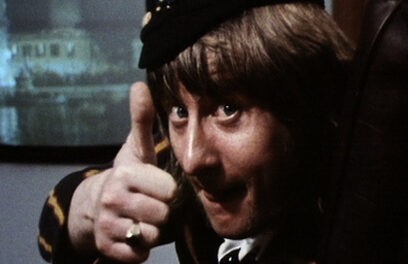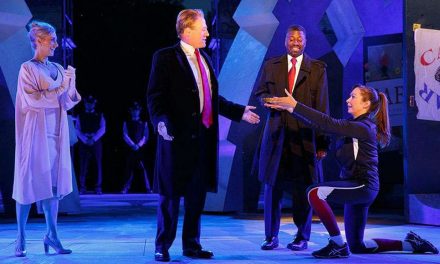Should a series be watched in production, broadcast, or some other order?
Most viewers will never consider this question, only turning their minds to the order in which episodes are aired or queued up on a DVD or streaming service if parts of an ongoing story are shown out of sequence. If a series is watchable in any order, the episode order issue is typically only the purview of dedicated television enthusiasts, with some preferring production order and others the order chosen by a particular broadcaster or the series’ creative team. Beyond personal preference, however, does the order in which one watches a series that was crafted to be understandable in any sequence have any measurable effect on one’s viewing experience?
Though I personally prefer production order viewing for the insights it provides into a show’s development, I have generally been of the opinion that each season of a continuity-free series will deliver a virtually identical viewing experience regardless of the order in which the episodes are watched. However, a recent rewatch of Randall and Hopkirk (Deceased) (1969-1970) has led me to reevaluate this conviction. For those unfamiliar with the series, it is a single-season British comedy-drama-thriller that follows the titular Jeff Randall and Marty Hopkirk, two friends who run a private detective agency. When Marty is killed during one of their investigations, he returns as a ghost and selects Jeff as the person who can see him. The pair continue their investigatory partnership, unbeknownst to Marty’s widow, Jean, who assists with the agency after Marty’s death. The series features a few instances in which it makes sense for certain episodes to be watched before or after others. Premiere episode “My Late Lamented Friend and Partner” sets up the series’ premise by depicting Marty’s death and return as a ghost, so it is best watched first. Jeff becomes reacquainted with Jean’s sister Jenny in “A Disturbing Case” and then employs her on a temporary basis in “The House on Haunted Hill,” so it makes sense to watch the former before the latter. Jeff tires of being haunted by the ghostly Marty after working several cases with him in “It’s Supposed To Be Thicker Than Water,” so this episode is best watched after viewing a number of others. In addition, the characters’ hairstyles, clothes, etc. may change suddenly, rather than gradually, if the episodes are watched in random order. However, none of these continuity elements is significant enough to affect one’s ability to understand and enjoy the show, so I originally assumed that the order in which the episodes were viewed would not affect one’s perception of the series.
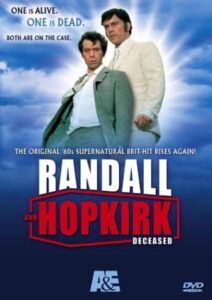
Fig. 1: A&E gave North American fans a way to watch vintage British series at the turn of the millennium.
My topsy-turvy initial viewing of the series in the mid-noughts supported this assumption. The only viewing option readily available to me in Canada at that time was a DVD release of the series that came courtesy of A&E. Optimistically billed as “Set 1” – “Set 2” sadly failed to materialise – the set purported to contain the “first thirteen” of the series’ 26 episodes, a highly subjective claim, as what constitutes the first half of the show depends on which order one is following. (This set followed the original transmission order utilised by the major commercial broadcaster London Weekend Television, an order that differed from the orders followed by the broadcaster that made the series (ATV) and other broadcasters.) After tiring of waiting for “Set 2” to appear, I acquired a Network DVD release of the series, which contained all 26 episodes in production order. As the A&E set had not been organised in production order, I had to pick through the Network set to see the other 13 episodes. I therefore saw half of the series in a production order riddled with gaps containing episodes I had already seen, and the other half in another order entirely. Still, I did not feel that my perception of the series was affected by this viewing order. My takeaway was that it was a light-hearted, sci-fi/detective series, and that it worked best as a comedy, with the odd darker, dramatic, or melancholy moment – Jean kidnapped and menaced by dangerous criminals in “Could You Recognise the Man Again?”; a lonely Marty wandering the streets at night in “Never Trust a Ghost” – standing out precisely because it was uncharacteristic of the series.
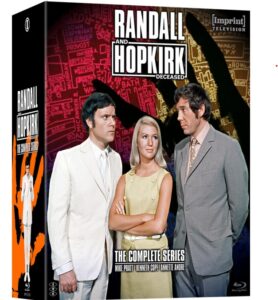
Fig. 2: Imprint’s Blu-ray release of the series.
This personal perception of the series held until Imprint Television’s 2024 Blu-ray release of the series offered the perfect excuse to rewatch it. Unlike the A&E set, this release contains all of the episodes and organises them in production order. Therefore, in watching this set, I saw the whole series in production order for the first time. I expected that my previous perception of the series as a primarily light-hearted, humorous one would hold with this rewatch. However, while the comedy was very much present and correct, watching the series in production order revealed to me a series that was darker, grittier, and more realistic and richly characterised than I recalled. As a result, I executed two about-faces: I now categorise the series as an essentially dramatic one with comedic overtones, and think it worked best when the balance tipped in favour of drama rather than comedy. While I was pleasantly surprised to find new layers to and perspectives on an old favourite, how did shifting the order in which I watched the same 26 episodes cause such a dramatic reassessment of the program?
The answer is that watching the series in production order highlights certain character continuity elements and a tonal shift that are broken up and rendered less noticeable by watching the episodes in another order. We will start with the tonal shift. When the series began, creative consultant and director Cyril Frankel and producer Monty Berman pushed for the show, ghost aside, to be a grounded, hard-boiled private detective series in the Philip Marlowe/Humphrey Bogart/Raymond Chandler/The Big Sleep mold. Stars Mike Pratt and Kenneth Cope, in contrast, were keen to foreground the series’ comedic elements. In a commentary for the episode “Vendetta for a Dead Man,” Frankel discussed these opposing viewpoints, and how he would rein in the stars’ comedic impulses in favour of maintaining “a sense of reality”. However, Frankel also indicated that, when he was not directing the series, the episodes became more “over the top”, as there was one fewer voice to push against the impetus to steer the series in a more comedic direction. This observation is borne out by the fact that the series’ tone gradually lightened up as production went on, in correlation with the increase in the size of the gaps between Frankel’s directorial entries. Perhaps the best example of the series’ increasingly comedic tone is an episode co-written by Mike Pratt himself, “A Disturbing Case,” which finds Jeff confined to a sinister clinic and placed in a drugged, hypnotic state. Marty helps Jeff to escape by doling out instructions that the hypnotised Jeff follows without question. Humorous, slapstick sequences ensue as a vacant-looking Jeff moves about with a bobbing gait, fights off assailants, and impersonates everyone from a martial arts expert to a German doctor. This episode’s slapstick action sequences differ greatly from the perilous fights Jeff engaged in in earlier episodes, and the whole of the episode has a lightness of touch that was not as pronounced in the show’s grittier early days. While this episode was the twenty-second of twenty-six to be filmed, and therefore produced during the series’ overtly comedic phase, the A&E set placed it second, and also front-loaded other more light-hearted episodes from late in the show’s production, such as “Murder Ain’t What It Used To Be!” (filmed 24th; broadcast in London 7th) and “The Ghost Who Saved the Bank at Monte Carlo” (filmed 23rd; broadcast in London 11th). The A&E set’s placement of these episodes earlier in the viewing order allowed them to set the tone of the show and led me to perceive it as inherently comedic. When I watched the show in production order, in contrast, I discovered that the first half to two-thirds of it build a world of thrills, danger, and consequence with each consecutive episode, uninterrupted by the more humorous episodes made later.
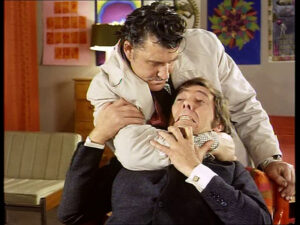
Fig. 3: Just another physically punishing day in the life of Jeff Randall in “When the Spirit Moves You.”
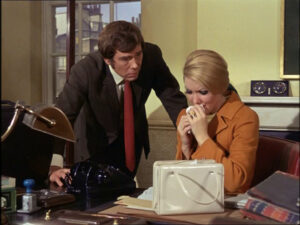
Fig. 4: Despite his difficult lot in life, Jeff always looks out for friends and others in need, especially Marty’s widow, Jean, whom he comforts in “Whoever Heard of a Ghost Dying?”
Production order also offers new perspectives on Jeff’s character. While any viewing order conveys that Jeff’s finances are not particularly healthy, the first half to two-thirds of production order drive home their truly dire state by making them a topical fixture, with Jeff unable to buy socks or pay the garage and Jeannie’s wages, forever in arrears, possessing a limited wardrobe that receives only intermittent additions, and eventually forced to attempt to pawn his belongings, only to be turned away by the pawnbroker. Jeff’s desperation and helpless anger at his situation build with each episode, so his crushing despair when he reaches rock bottom – the pawn shop – feels like the natural culmination of everything that has come before. There is a similar cumulative effect at work when watching Jeff’s fights in production order. The fights filmed earlier in the series find Jeff enduring unvarnished physical punishment, and, when the blows are not softened by the slapstick action sequences featured later in the series, each attack seems to beat Jeff a little further into the ground. At the same time, Jeff’s willingness to not only keep going in the face of these travails, but endure additional hardship to protect his friends (he saves Marty from exorcism, Jean from all sorts of peril, and a friend from being arrested) and do right by others (he continues to work for a client who paid him up front, even after the man dies) casts him in a noble light that is dimmed by a viewing order that redistributes, and therefore reduces the intensity of, the misfortunes he overcomes. Production order therefore better conveys Jeff’s characterisation as a nuanced, poignant, and self-sacrificing individual who is arguably one of the most richly layered ITC heroes, despite lacking his peers’ advantages of money, fame, and professional standing.
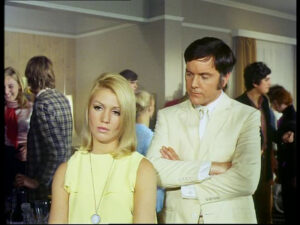
Fig. 5: A melancholy Jean ignores the revelry around her in favour of thinking of her late husband, while the ghostly spirit of the man himself looks on in “Who Killed Cock Robin?”
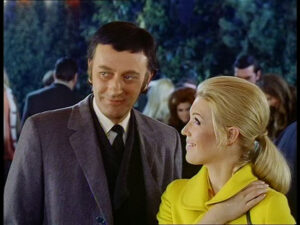
Fig. 6: A happier Jean enjoys the company of her new beau in “Vendetta for a Dead Man.”
Jean’s evolution as a character is also more apparent in production order. At the start of the series, Jean’s grief at Marty’s death renders her melancholy, soft-spoken, and tentative. She brings flowers to Marty’s grave and becomes depressed and emotional when she is told that Marty is a tortured ghost trapped in the afterlife. She relies on Jeff for emotional support and protection. She attends parties, but, unless encouraged to socialise, isolates herself in favour of thinking of Marty. She initially struggles with her work at the detective agency, and is uncertain when dealing with Jeff’s clients. Sometimes she is too emotionally fragile to work, leading Jeff to send her home. However, as the series goes on, Jean begins to recover from Marty’s death and becomes less emotionally fragile, more assertive, and keen to take control of her life. She entertains new employment, becomes more efficient and confident in handling the agency’s business – to the point of bossing Jeff around – and suggests ways of finding new clients. She becomes adept at dealing with strange occurrences, be it posing as Jeff’s lover to give him an alibi or calmly interrogating a man who claims to be a reincarnated Marty. She dates and considers marrying again. She becomes less reliant on Jeff for emotional support and physical protection, and instead hints that she sees him as a romantic prospect. Production order therefore realistically tracks Jean’s evolution from a grief-stricken, fragile widow to a more confident, capable woman, character progression that is lost by watching episodes in another order.
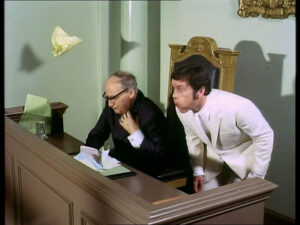
Fig. 7: Marty delays court proceedings by blowing papers around in “Could You Recognise the Man Again?”
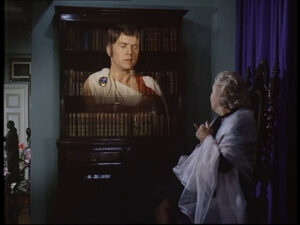
Fig. 8: Marty communicates with a fake psychic who turns out to have real powers in “But What A Sweet Little Room”, his first ghostly conversation with someone other than Jeff.
Production order viewing also allows one to track Marty’s learning curve in relation to his ghostly abilities. As the series progresses, he learns how to whip up wind and walk through walls, identifies who he can communicate with (psychics/clairvoyants/mediums and those under hypnosis, hovering between life and death, and in comas), discovers that animals can see him, and learns how to move and manipulate objects and interfere with compasses and electronic equipment. In production order, once Marty learns an ability, he typically remembers it and utilises it on subsequent occasions. Watching episodes in another order, however, finds Marty “discovering” previously used powers or neglecting to use ones he already knows about, which is unsatisfying from both a continuity and character development perspective.
If watching Randall and Hopkirk (Deceased)’s episodes in production order resulted in a richer viewing experience, I wonder what would happen if I repeated the experiment with other series that I originally viewed according to the whims of broadcasters and DVD set compilers…?
With thanks to Andrew Pixley
JZ Ferguson is an enthusiast of British popular culture with a particular affinity for television series of the sixties and seventies. She has written for all five, and co-edited two, of the volumes of The Avengers on film series. She has also written for the Classic British Television Drama series, penning chapters on shows such as The Saint, Danger Man, The Persuaders!, and Gideon’s Way. Other volumes featuring her work include Swinging TV, Survival TV, New Waves, and Man in a Suitcase: A Critical Guide. Escapades: An Exploration of Avengers Curiosities, her latest publication co-authored with Alan Hayes, is available now from Quoit Media. She lives in Canada.



